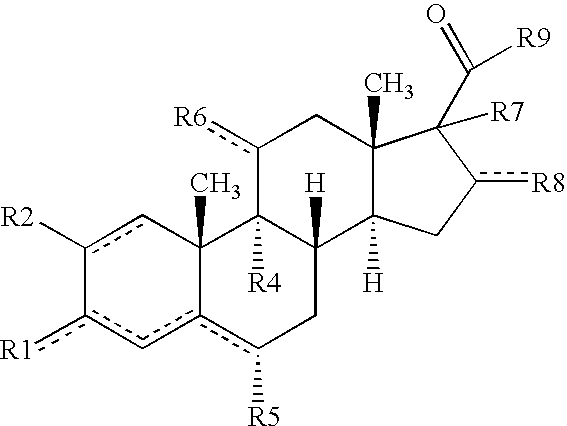Treatment of genitourinary tract disorders
a genital tract disorder and genital tract technology, applied in the field of genital tract disorders, can solve the problems of significant loss of radiation seed life, increased side effects or even radiation injury, substantial and prolonged swelling of the prostate, etc., and achieve the effect of influencing the release rate and the hydrolysis rate of prodrug or codrug
- Summary
- Abstract
- Description
- Claims
- Application Information
AI Technical Summary
Benefits of technology
Problems solved by technology
Method used
Image
Examples
example 1
Codrug (2) of Flurbiprofen with 5-Fu (Scheme 1)
[0256] Bis(hydroxymethyl) 5-fluorouracil (1), (0.17 g) was dissolved in 3 mL of anhydrous acetonitrile under argon. To this stirred solution at room temperature was added triethylamine (0.195 mL) followed by acid chloride of flurbiprofen (0.282 g). The cloudy mixture was stirred at room temperature overnight, diluted with 10 mL of dichloromethane, washed with 1 M HCl, aq. sodium bicarbonate, water, brine and dried over sodium sulfate. The oily residue after solvent evaporation was purified by column chromatography on silica gel using chloroform-methanol 100:1 to afford 0.19 g of the codrug (2) as a colorless crystalline solid. 1H NMR (CDCl3), 1.50 (d, 3H), 3.94 (q, 1H), 5.72 (s, 2H), 7.22 (dd, 2H), 7.37-7.57 (m, 6H), 7.92 (d, 1H).
example 2
Codrug (3) of Indomethacin with 5-FU (Scheme 1)
[0257] Bis(hydroxymethyl) 5-fluorouracil (0.39 g) was dissolved in 15 mL of anhydrous acetonitrile under argon. To this stirred solution was added indomethacin (0.81 g) followed by DCC (0.46 g) and catalytic amount of DMAP. The resulting yellow suspension was stirred at room temperature overnight and evaporated to dryness under vacuum. The solid residue was then purified by column chromatography on silica gel in chloroform-methanol 100:2 to afford 0.63 g of the codrug (3). 1H NMR (DMSO d6), 2.20 (s, 3H), 3.72 (s, 3H), 5.60 (s, 2H), 6.68 (m, 1H), 6.91 (d, 1H), 7.00 (d, 1H), 7.63 (s, 5H), 8.12 (d, 1H).
example 3
Codrug (4) of Sulindac with 5-FU (Scheme 1)
[0258] Bis(hydroxymethyl) 5-fluorouracil (0.40 g) was dissolved in 5 mL of anhydrous acetonitrile under argon. To this stirred solution was added sulindac (0.75 g) followed by EDCI (0.40 g) and catalytic amount of DMAP. The orange mixture soon turned homogenous and it was kept overnight at room temperature in darkness. Evaporation of the solvent left the crude residue which was dissolved in dichloromethane (20 mL) and washed twice with water, once with saturated sodium bicarbonate, water and brine. The extract was dried over sodium sulfate, evaporated and purified by column chromatography on silica gel using chloroform-methanol 30:1 as solvent system to yield 0.69 g of codrug (4). 1H NMR (CDCl3), 2.20(s, 3H), 2.82 (s, 3H), 3.64 (s, 2H), 5.66 (s, 2H), 6.57 (m, 1H), 6.81 (dd, 1H), 7.15 (m, 2H), 7.51 (d, 1H), 7.70 (dd, 4H).
PUM
 Login to View More
Login to View More Abstract
Description
Claims
Application Information
 Login to View More
Login to View More - R&D
- Intellectual Property
- Life Sciences
- Materials
- Tech Scout
- Unparalleled Data Quality
- Higher Quality Content
- 60% Fewer Hallucinations
Browse by: Latest US Patents, China's latest patents, Technical Efficacy Thesaurus, Application Domain, Technology Topic, Popular Technical Reports.
© 2025 PatSnap. All rights reserved.Legal|Privacy policy|Modern Slavery Act Transparency Statement|Sitemap|About US| Contact US: help@patsnap.com



